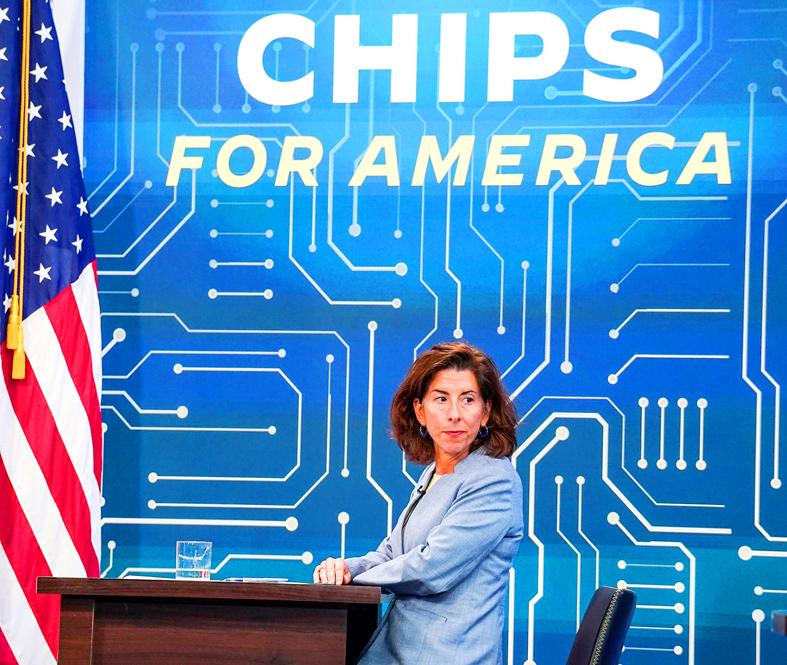The US’ latest ban on advanced electronic design automation (EDA) software exports to China might hinder Chinese chip companies from accessing advanced semiconductor technology, as they attempt to upgrade to 3-nanometer processes in the next three to five years, market researcher TrendForce Corp (集邦科技) said yesterday.
The US Department of Commerce’s Bureau of Industry and Security on Friday announced bans on EDA tools for gate-all-around field-effect transistors (GAAFET), a new-generation semiconductor technology that US chipmaker Intel Corp and Samsung Electronics Co from South Korea are adopting to make 4-nanometer and 3-nanometer chips.
The bureau in a statement said that gate-all-around field-effect transistor structure is key to designing ICs used in military equipment, including defense satellites.

Photo: Bloomberg
Chinese chip designers and foundry service providers lag behind the world’s major chipmakers in developing advanced chips, so the ban of software to design GAAFET technology should not have any substantial effect on them in the short term, the Taipei-based researcher said.
However, “Chinese chip designers will encounter difficulties in designing new-generation chips from the initial design to back-end system design,” TrendForce said in a report.
The world’s top two EDA tool suppliers — Synopsys Inc and Cadence Design Systems Inc, both based in the US — have a combined 62 percent share of the world market, while Siemens EDA, ranked third, has a 13 percent share, TrendForce data showed.
Although Chinese chip designers and foundry companies have already secured a vast amount of EDA software, the companies would still face restrictions from updating those programs for further use in designing chips, the researcher said.
Empyrean Technology Co Ltd (華大九天), China’s biggest EDA software provider, lags far behind its US peers in terms of technology development and revenue scale, TrendForce said.
Empyrean cannot compete with US rivals in digital circuit design EDA, foundry EDA and next-generation GAAFET design software, it said.
The Beijing-based company is good at providing mature EDA technology including analog circuit and flat-panel display circuit design tools, TrendForce said.
The EDA software market is expected to expand at a compound annual growth rate of 13.8 percent to US$13.6 billion from last year to 2024, it said.
The US Bureau of Industry and Security issued an interim final rule that imposes new export controls on four technologies including additional equipment, software and technology used to produce semiconductors.
One of the four technologies is electronic computer-aided design software specially designed for the development of integrated circuits with GAAFET structure, as well as pressure gain combustion technology, the bureau said in a statement posted on its Web site.
Electronic computer-aided design software is a category of tools used for designing, analyzing, optimizing and validating the performance of integrated circuits or printed circuit boards. It is used in a variety of applications by the military and aerospace defense industries for designing complex integrated circuits, the statement said.
GAAFET technology is key to scaling to 3-nanometer and smaller technology nodes, the bureau said.
GAAFET enables faster, more energy efficient and more radiation-tolerant integrated circuits that can advance many commercial and military applications, including defense and communications satellites, it added.

CHIP RACE: Three years of overbroad export controls drove foreign competitors to pursue their own AI chips, and ‘cost US taxpayers billions of dollars,’ Nvidia said China has figured out the US strategy for allowing it to buy Nvidia Corp’s H200s and is rejecting the artificial intelligence (AI) chip in favor of domestically developed semiconductors, White House AI adviser David Sacks said, citing news reports. US President Donald Trump on Monday said that he would allow shipments of Nvidia’s H200 chips to China, part of an administration effort backed by Sacks to challenge Chinese tech champions such as Huawei Technologies Co (華為) by bringing US competition to their home market. On Friday, Sacks signaled that he was uncertain about whether that approach would work. “They’re rejecting our chips,” Sacks

Taiwan’s long-term economic competitiveness will hinge not only on national champions like Taiwan Semiconductor Manufacturing Co. (TSMC, 台積電) but also on the widespread adoption of artificial intelligence (AI) and other emerging technologies, a US-based scholar has said. At a lecture in Taipei on Tuesday, Jeffrey Ding, assistant professor of political science at the George Washington University and author of "Technology and the Rise of Great Powers," argued that historical experience shows that general-purpose technologies (GPTs) — such as electricity, computers and now AI — shape long-term economic advantages through their diffusion across the broader economy. "What really matters is not who pioneers

In a high-security Shenzhen laboratory, Chinese scientists have built what Washington has spent years trying to prevent: a prototype of a machine capable of producing the cutting-edge semiconductor chips that power artificial intelligence (AI), smartphones and weapons central to Western military dominance, Reuters has learned. Completed early this year and undergoing testing, the prototype fills nearly an entire factory floor. It was built by a team of former engineers from Dutch semiconductor giant ASML who reverse-engineered the company’s extreme ultraviolet lithography (EUV) machines, according to two people with knowledge of the project. EUV machines sit at the heart of a technological Cold

TAIWAN VALUE CHAIN: Foxtron is to fully own Luxgen following the transaction and it plans to launch a new electric model, the Foxtron Bria, in Taiwan next year Yulon Motor Co (裕隆汽車) yesterday said that its board of directors approved the disposal of its electric vehicle (EV) unit, Luxgen Motor Co (納智捷汽車), to Foxtron Vehicle Technologies Co (鴻華先進) for NT$787.6 million (US$24.98 million). Foxtron, a half-half joint venture between Yulon affiliate Hua-Chuang Automobile Information Technical Center Co (華創車電) and Hon Hai Precision Industry Co (鴻海精密), expects to wrap up the deal in the first quarter of next year. Foxtron would fully own Luxgen following the transaction, including five car distributing companies, outlets and all employees. The deal is subject to the approval of the Fair Trade Commission, Foxtron said. “Foxtron will be